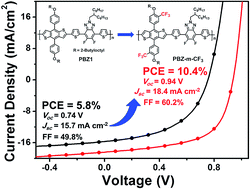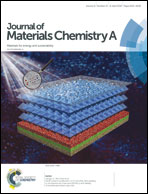A trifluoromethyl substituted wide bandgap conjugated polymer for non-fullerene polymer solar cells with 10.4% efficiency†
Abstract
A new wide bandgap copolymer (PBZ-m-CF3) based on meta-trifluoromethyl-p-alkoxyphenyl substituted benzodithiophene (BDTP-m-CF3) and difluorobenzotriazole (FBTZ) was successfully designed and synthesized for efficient non-fullerene polymer solar cells (PSCs). As a comparative material, a wide bandgap copolymer (PBZ1) based on p-alkoxyphenyl substituted benzodithiophene (BDTP) and FBTZ was synthesized by the same method. It was found that introducing trifluoromethyl into the meta-position of the phenyl group led to PBZ-m-CF3 possessing a deeper HOMO energy level of −5.49 eV, a wider optical bandgap (Eoptg) of 1.99 eV with a higher extinction coefficient of 6.51 × 104 cm−1 at 533 nm and a suitable hole mobility of 7.86 × 10−4 cm2 V−1 s−1 in comparison with PBZ1 (a HOMO level of −5.27 eV, an Eoptg of 1.96 eV with an extinction coefficient of 5.23 × 104 cm−1 at 539 nm and a hole mobility of 7.23 × 10−4 cm2 V−1 s−1). Non-fullerene bulk heterojunction PSCs based on PBZ-m-CF3 as the donor and ITIC as the acceptor were fabricated by using toluene as the solvent and showed a higher PCE of 10.4% with a high Voc of 0.94 V, a Jsc of 18.4 mA cm−2, and a FF of 60.2% compared with PSCs based on PBZ1: ITIC (a PCE of 5.8% with a Voc of 0.74 V, a Jsc of 15.7 mA cm−2, and a FF of 49.8%). These results demonstrate that a benzodithiophene unit with meta-trifluoromethyl-p-alkoxyphenyl side chains is a promising candidate as an electron-rich building block for high performance PSCs.



 Please wait while we load your content...
Please wait while we load your content...